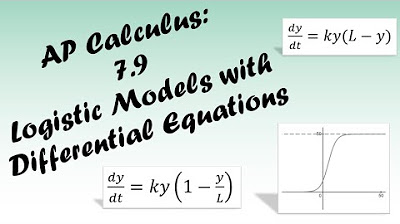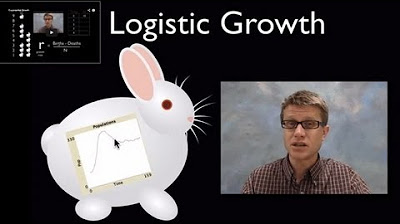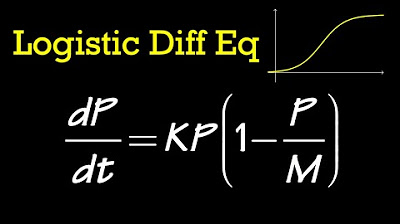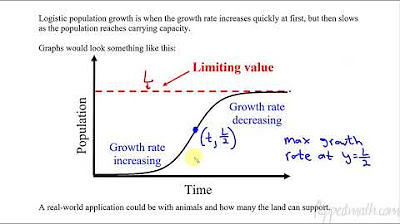Logistic Differential Equation
TLDRThis video script delves into the logistic differential equation, a model for constrained growth scenarios like population growth or disease spread. It introduces the equation's form, dp/dt = k*p*(1 - p/L), where 'p' is population, 'L' is carrying capacity, and 'k' is the growth rate constant. The S-shaped graph of logistic growth is highlighted, with the carrying capacity being the upper limit where growth levels off. Key points include the maximum growth rate occurring at half the carrying capacity and the presence of an inflection point at this point. The script also provides insights into the equation's application in real-world scenarios, such as infectious disease spread, and concludes with examples to solidify understanding.
Takeaways
- 📚 The logistic differential equation models scenarios like population growth or the spread of diseases, with a focus on constrained growth.
- 🔍 The standard form of the logistic differential equation is \( \frac{dp}{dt} = k \cdot p \cdot (1 - \frac{p}{L}) \), where \( p \) is the population, \( t \) is time, \( L \) is the carrying capacity, and \( k \) is a constant.
- 📈 The graph of the logistic equation typically has an S-shaped curve, indicating the growth rate slows as the population approaches the carrying capacity.
- 📉 If the initial population is above the carrying capacity, there will be a die-off, illustrating the importance of the carrying capacity in the model.
- 🧩 The carrying capacity \( L \) is proven to be the upper limit the population approaches as time goes to infinity.
- 📊 The maximum growth rate of the population occurs at half the carrying capacity, which is a crucial point for understanding the dynamics of logistic growth.
- 🔺 There is an inflection point in the logistic growth curve at half the carrying capacity, indicating a change in the concavity of the growth curve.
- 🌐 The logistic equation can be applied to various fields such as biology, environmental science, and human geography.
- 📝 For AP Calculus BC, understanding the form of the equation, the graph shape, the carrying capacity, and the maximum growth rate are essential.
- 📑 The solution to the logistic differential equation is not typically tested on AP Calculus exams but is important for a deeper understanding of the topic.
- 📚 Practice with logistic differential equations is encouraged to become familiar with different forms of the equation and their applications.
Q & A
What is a logistic differential equation typically used to model?
-A logistic differential equation is typically used to model scenarios involving constrained growth, such as the population of animals, the spread of an infectious disease, or any situation where growth is limited by a carrying capacity.
What does the variable 'p' represent in the logistic differential equation?
-'p' in the logistic differential equation represents the population at a given time.
What is the role of 't' in the logistic differential equation?
-'t' represents time in the logistic differential equation, but it is not a variable that is regularly used in the equation's solutions.
What is meant by 'carrying capacity' in the context of logistic growth?
-The 'carrying capacity' refers to the maximum population size that an environment can sustain indefinitely, given the food, habitat, water, and other necessities available in the environment.
What is the role of the constant 'k' in the logistic differential equation?
-'k' is a constant in the logistic differential equation that dictates how fast the growth is happening. It affects the rate at which the population increases or decreases.
What is the general shape of the graph for the solution of a logistic differential equation?
-The graph of the solution of a logistic differential equation typically has an S-shaped curve, indicating a slow start, rapid growth in the middle, and then leveling off as the population approaches the carrying capacity.
At what point does the maximum growth rate occur in a logistic growth scenario?
-The maximum growth rate in a logistic growth scenario occurs when the population is at half the carrying capacity.
What happens if the initial population is above the carrying capacity in a logistic growth model?
-If the initial population is above the carrying capacity, there will be a die-off, as the environment cannot support the population, leading to a decrease in population size.
How does the logistic differential equation relate to the spread of an infectious disease?
-In the context of infectious disease spread, the logistic differential equation can model how the disease spreads through a population. The growth rate of the disease is initially high when few people are infected, but as more people become immune or recover, the rate of new infections decreases.
What are the four key things one needs to know about the logistic differential equation for AP Calculus BC?
-For AP Calculus BC, one needs to know the form of the logistic differential equation (dp/dt = k * p * (l - p)), the general shape of the graph (S-shaped curve), the meaning of 'l' as the carrying capacity, and the fact that the maximum growth rate occurs when the population is half of the carrying capacity.
Outlines
📚 Introduction to Logistic Differential Equations
This paragraph introduces the logistic differential equation, which is used to model scenarios of constrained growth such as population growth or the spread of diseases. The logistic equation is presented in the form dp/dt = k * p * (1 - p/L), where p represents the population, t is time, L is the carrying capacity (an upper limit to growth), and k is a constant that dictates the growth rate. The paragraph emphasizes the importance of recognizing the logistic form of a differential equation and understanding its variables and parameters.
📈 Understanding the Logistic Growth Graph
The second paragraph delves into the graphical representation of the logistic differential equation, illustrating the characteristic S-shaped curve that represents growth constrained by the carrying capacity. It explains that the curve levels off as it approaches the carrying capacity, indicating a maximum sustainable population or growth rate. The paragraph also discusses the implications of starting with a population size above the carrying capacity, which would lead to a decline. Additionally, it touches on the mathematical proof that the carrying capacity L is indeed the upper limit of the growth, as the limit of p(t) as t approaches infinity is L.
📚 Key Facts about Logistic Differential Equations
This paragraph presents several key facts about logistic differential equations. It highlights that the maximum growth rate occurs at half the carrying capacity, which is a crucial piece of information for understanding how these equations model real-world scenarios. The paragraph also explains the concept of an inflection point, which occurs at the maximum growth rate, indicating a change in the concavity of the growth curve. The discussion includes the application of these concepts to the spread of infectious diseases, where the growth rate is initially low, peaks when half the population is infected, and then declines as it becomes harder to find new hosts.
📝 Applying Logistic Differential Equations in Problems
The final paragraph focuses on applying the knowledge of logistic differential equations to solve problems. It provides examples of how to identify the carrying capacity from an equation and how to calculate the growth rate at different population sizes. The paragraph also demonstrates how to find the value of k, the growth constant, using given information about the rate of population increase at a specific time. It concludes by emphasizing the importance of understanding the form of the equation, the shape of the graph, the concept of carrying capacity, and the maximum growth rate for success in AP Calculus BC exams.
Mindmap
Keywords
💡Logistic Differential Equation
💡Population
💡Carrying Capacity (L)
💡Exponential Growth
💡Growth Rate
💡S-shaped Curve
💡Inflection Point
💡Derivative
💡Infectious Disease Spread
💡Maximum Growth Rate
💡AP Calculus
Highlights
The video discusses the logistic differential equation, which models population growth or the spread of diseases under constraints.
The logistic differential equation is given by dp/dt = k * p * (1 - p/L), where p is population, t is time, L is carrying capacity, and k is a constant.
The carrying capacity, L, represents the maximum population size that the environment can sustain.
The logistic equation can be recognized in different forms, including dy/dx = number * y * (carrying capacity - y).
The graph of the logistic equation typically shows an S-shaped curve, indicating constrained growth.
The carrying capacity, L, is the limit of the population size as time approaches infinity.
The logistic growth curve levels off as it approaches the carrying capacity, unlike exponential growth.
If the initial population is above the carrying capacity, there will be a die-off, demonstrating the importance of starting conditions.
The solution to the logistic differential equation is derived and can be used to prove that L is the carrying capacity.
The maximum growth rate of the population occurs at half the carrying capacity, which is a key fact for understanding logistic growth.
A point of inflection on the logistic curve corresponds to the maximum growth rate, indicating a change in concavity.
The logistic differential equation can be applied to model the spread of infectious diseases, where growth rate is influenced by the number of susceptible hosts.
In the context of infectious diseases, the growth rate is low when few are infected and declines as the disease approaches saturation.
Four key aspects of the logistic differential equation for AP Calculus BC include its form, graph shape, carrying capacity, and maximum growth rate.
Examples are provided to illustrate how to identify and work with logistic differential equations in various contexts.
The video concludes with a summary of the essential knowledge required for AP Calculus BC regarding logistic differential equations.
Transcripts
Browse More Related Video
5.0 / 5 (0 votes)
Thanks for rating:





